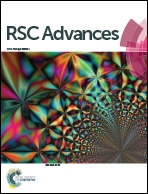Synthesis of biocarbon coated Li3V2(PO4)3/C cathode material for lithium ion batteries using recycled tea
Abstract
A biocarbon coated Li3V2(PO4)3/C (LVP-C) cathode material was synthesized by a facile sol–gel method using recycled tea as both the structural template and biocarbon source. X-ray diffraction (XRD) patterns show that LVP has a monoclinic structure with space group P21/n. High-resolution transmission electron microscopy (HRTEM) images show that the LVP nanoparticles are surrounded by amorphous biocarbon, and the thickness of the biocarbon shell is about 10–20 nm. Electrochemical measurements demonstrate that the LVP-C nanocomposite shows a significantly better rate capability and cycling performance than pure LVP. In the potential range of 3.0–4.3 V, the LVP-C nanocomposite delivers a high initial discharge capacity of 132 mA h g−1 at 0.5 C, and maintains an initial discharge capacity of 110 mA h g−1 at 10 C. After 80 cycles at 10 C, it still retains a discharge capacity of 110 mA h g−1. Electrochemical impedance spectroscopy (EIS) measurements have disclosed that the LVP-C sample exhibits enhanced electrode reaction kinetics and improved electrochemical performance. The good electrochemical performance of the LVP-C nanocomposite is mainly related to the presence of the conductive biocarbon, thus leading to an improvement in the electron and lithium ion diffusivity. These results indicate that the biocarbon coated LVP-C material is a promising candidate for large capacity and high power cathode materials in next generation lithium-ion batteries for electric vehicles.


 Please wait while we load your content...
Please wait while we load your content...